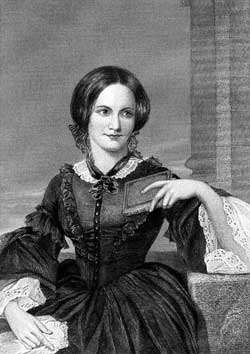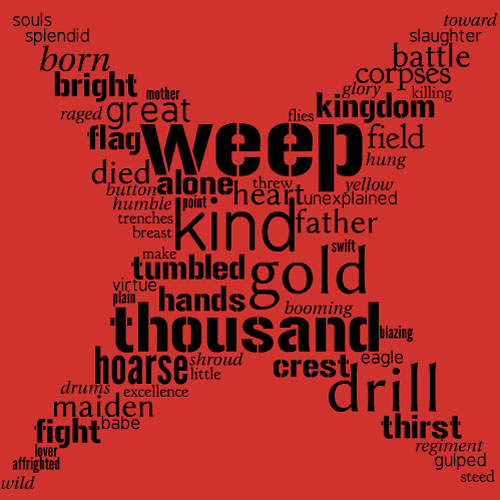Introduction
 As readers, we like to make pictures in our heads as we read. Visualizing as we read helps us to understand what we are reading. Sometimes, we like our own pictures so much that when we go to the movies to see a film made from a book we’ve read, we don’t like the movie because it isn’t as good as the pictures in our heads. How are we able to make pictures in our heads? This ability is made easier for us when writers use imagery in their stories and poems. If a writer uses sensory details or words that appeal to our senses, then we are able to use our senses and our memory to almost experience the details we are reading about. When we are able to see, hear, taste, touch, and smell as we read, we are then able to better understand what we’re reading. If you read about someone eating a chocolate ice cream cone, all of your senses, plus your memory of eating ice cream, kick in to aid your understanding of the experience of eating an ice cream cone. In this lesson, you will learn how writers use words that allow them to create the pictures in your head.
As readers, we like to make pictures in our heads as we read. Visualizing as we read helps us to understand what we are reading. Sometimes, we like our own pictures so much that when we go to the movies to see a film made from a book we’ve read, we don’t like the movie because it isn’t as good as the pictures in our heads. How are we able to make pictures in our heads? This ability is made easier for us when writers use imagery in their stories and poems. If a writer uses sensory details or words that appeal to our senses, then we are able to use our senses and our memory to almost experience the details we are reading about. When we are able to see, hear, taste, touch, and smell as we read, we are then able to better understand what we’re reading. If you read about someone eating a chocolate ice cream cone, all of your senses, plus your memory of eating ice cream, kick in to aid your understanding of the experience of eating an ice cream cone. In this lesson, you will learn how writers use words that allow them to create the pictures in your head.
Imagery in Action
Look at these three sentences.
Sentence #1:
The dogs went down the street after the boy.
Are the dogs chasing the boy, or are they all in a row—one after the other behind the boy? We don’t know because we don’t have enough information to finish the picture in our heads. If you’re reading the sentence, you might picture a boring street with a young boy in short pants being followed by several brown and white spotted dogs. Most of what you see as you read is a result of your own creation and not the writer’s words!
Using imagery adds detail to the writing that helps to create vivid pictures in the reader’s head. These details are usually words relating to the five senses: sight, sound, touch, taste, and smell. Now let’s add some sensory words to the sentence above.

Sentence #2:
Two hairy dogs chased the little boy down the street as he furiously pedaled his shiny silver bicycle.
Now read sentence #3. Both sentence #2 and sentence #3 begin with the same sentence starter, but because of word choices the writer makes, the pictures you visualize in your head are very different for each sentence.

Sentence #3:
Two French poodles pranced down the street, their top-knotted tails at attention behind them, while a small boy tugged impatiently on their jeweled leashes and scolded them in rapid French.
Choose either sentence #2 or sentence #3 and list all of the words in the sentence that help you make a picture in your head as you read.
Use the Take Notes Tool to write your response. When you're finished, check your understanding.
For sentence #2, you may have chosen: three, large, hairy, chased, rode, shiny, silver, or bicycle.
For sentence #3, you may have chosen: two, French poodles, pranced, top-knotted tails, at attention, small, tugged, impatiently, jeweled, scolded, rapid, or French.
CloseImagery in Characterization
You learned in the last section that writers can start with a basic idea—a boy being followed by dogs—and by adding words that appeal to our senses, they can end up with two very different stories. Writers use imagery when they want us to have as much information about a character as possible. The clues that we get from sensory words give us ideas about the character that go beyond how they look. In the two passages that follow, the writers have very different styles, but both use imagery to allow the reader to get a clear idea of what each character looks like and even some insight into their personalities.
The first example of imagery is from the short story “A Worn Path” by Eudora Welty. After you finish reading, follow the directions and answer the questions that follow.
She wore a dark striped dress reaching down to her shoe tops, and an equally long apron of bleached sugar sacks, with a full pocket: all neat and tidy, but every time she took a step she might have fallen over her shoelaces, which dragged from her unlaced shoes. She looked straight ahead. Her eyes were blue with age. Her skin had a pattern all its own of numberless branching wrinkles and as though a whole little tree stood in the middle of her forehead, but a golden color ran underneath, and the two knobs of her cheeks were illumined by a yellow burning under the dark. Under the red rag her hair came down on her neck in the frailest of ringlets, still black, and with an odor like copper.
What is the most important image in the description of the woman in the text? Does her physical description tell you something about her character or her personality? Explain your answer and support it with evidence from the reading passage.
Use the Take Notes Tool to write your response. When you’re finished, check your understanding.
You might have written that since the apron was made from sugar sacks, the woman might be poor. The image of the unlaced shoes might also support this idea. While a lot of the description suggests that she is old, there is also description to suggest that she is poor.
CloseThe next example of imagery used in characterization is an excerpt from the novel Jane Eyre by Charlotte Brontë. After you finish reading, follow the directions and answer the questions that follow.
 Engraving of author
Engraving of authorCharlotte Brontë
Two young ladies appeared before me; one very tall, almost as tall as Miss Ingram—very thin too, with a sallow face and severe mien. There was something ascetic in her look, which was augmented by the extreme plainness of a straight-skirted, black, stuff dress, a starched linen collar, hair combed away from the temples, and the nun-like ornament of a string of ebony beads and a crucifix. This I felt sure was Eliza, though I could trace little resemblance to her former self in that elongated and colorless visage.
What is the most important image in the description of the woman in the text? Again, can you make some predictions about the character based on the sensory words in the passage? Explain your answer and support it with evidence from the reading passage.
Use the Take Notes Tool to write your response. When you're finished, check your understanding.
Because of the imagery here—the description of her face as sallow and severe and her clothes as plain—we might think that either Eliza is not happy, or that she is very serious.
CloseNow think of someone you know and follow the patterns above to write a short description of that person. Readers should be able to imagine what the person looks like based on your description. Use lots of words that ask the reader to see, hear, touch, taste, and smell.
In the space provided, try your hand at creating sensory images as you write.
Use the Take Notes Tool to write your response. When you're finished, check your understanding.
Here’s an example of someone I used to see in my neighborhood when I was growing up:
“Walking Henry”, as we called him, was homeless before I knew the word “homeless” and knew that homeless people existed. He scavenged through our garbage can every couple of days. He was old with thick sun-hardened wrinkled skin, his face caved in so that he was all eyes, nose, and jowls; he had no teeth. Sometimes I got close enough to see the stickery-white hairs on his chin. He always wore an old no-color coat, floppy pants, and a pith helmet. If you got close to him, he would look at you and mumble under his breath in a Polish-English mish mash, but keep to his task of sorting through yesterday’s supper scraps, as though he didn’t want to be bothered making that day’s dining decisions.
CloseConcrete and Abstract Ideas
Read the following poem by William Carlos Williams.
so much depends
upon
a red wheel
barrow
glazed with rain
water
beside the white
chickens
You’re probably scratching your head now wondering what you’ve just read and why. William Carlos Williams often wrote small, spare poems crammed with imagery. The images in his poems are simple, but he asks the reader to consider what these images mean. He’s asking you to think in abstract terms about the imagery. You can find the concrete imagery in the poem easily—the red wheelbarrow, the rain, the water, and the white chickens—but he wants you to consider the imagery in abstract terms as well. That’s why he doesn’t give you any clues other than the first line, “so much depends.”
How and why does so much depend on the red wheelbarrow in the rain beside the white chickens? You might imagine a farm, and as you think about the farm, you might think about the importance of the wheelbarrow to the farm’s productivity, or you might enlarge your thinking so that you imagine how everything is connected. The wheelbarrow is connected to the chickens, the chickens are connected to the farm, and the farm is connected to the outside world. You moved from a few simple images to big ideas about the world. You moved from a concrete to an abstract idea.
Let’s read another small poem, full of imagery, by Amy Lowell.
Cold, wet leaves
Floating on moss-colored water,
And the croaking of frogs—
Cracked bell-notes in the twilight.
This poem is all about the images. This poet doesn’t provide you with a way to think about the poem as Williams does in the poem you just read. So what does Amy Lowell want us to do with this poem, aside from enjoy the imagery and make interesting pictures in our heads as we read? When you answer this question, you are moving into the abstract discussion of the poem. My guess is that she would like us to think about mood here. Imagine how you would feel as you look and listen to the pond she describes. You might begin thinking about the power that nature has to make us feel certain ways.
Now it’s your turn to write a poem similar to “The Red Wheelbarrow” or “The Pond.” You can use any subject you wish. Think about the images you want to use and decide what you want those images to convey to a reader.
Use the Take Notes Tool to write your response. When you're finished, check your understanding.
First example:
The Pink Bracelets
how little difference
my lucky pink plastic bracelets
make
lying all warm and snuggly
in my jewelry box
instead of on my
shivering goose-pimpled arm
in this cold, fluorescent lighted
math class.
Second example:
The Camp Out
Hot smell of bacon
Crackling in the black iron skillet
And the burbling of coffee—
Civilized necessities In the wilderness
Test for Understanding
Review the artwork below. It contains words in the poem “Do Not Weep Maiden, For War Is Kind”.

For your final activity, let’s see if we can put everything together we’ve learned so far. Read the poem “Do Not Weep Maiden, For War Is Kind” by Stephen Crane. Using your Take Notes Tool, write down the words from the passage that create imagery. After you finish reading, answer the questions below.
 Engraving of poet
Engraving of poet Stephen Crane
Do not weep, maiden, for war is kind.
Because your lover threw wild hands toward the sky
And the affrighted steed ran on alone,
Do not weep.
War is kind.
Hoarse, booming drums of the regiment,
Little souls who thirst for fight,
These men were born to drill and die.
The unexplained glory flies above them,
Great is the battle-god, great, and his kingdom—
A field where a thousand corpses lie.
Do not weep, babe, for war is kind.
Because your father tumbled in the yellow trenches,
Raged at his breast, gulped and died,
Do not weep.
War is kind.
Swift blazing flag of the regiment,
Eagle with crest of red and gold,
These men were born to drill and die.
Point for them the virtue of slaughter,
Make plain to them the excellence of killing
And a field where a thousand corpses lie.
Mother, whose heart hung humble as a button
On the bright splendid shroud of your son,
Do not weep.
War is kind.
Answer these six questions about imagery in the poem and its effect on you, the reader.
- Why is the use of imagery important when the poet describes the drums?
- In the second stanza, you have a description of the “little souls.” What do you think the poet means by describing these soldiers as “little souls”? Hint: Think about how Crane continues to describe these soldiers in the rest of the stanza.
- What does the use of the color “yellow” suggests about the trenches? Hint: Can you think in concrete and abstract ways about the word “yellow”?
- Why are the colors “red” and “gold” important when the poet describes the flag the regiment is carrying?
- Explain the image of the “Mother, whose heart hung humble as a button.”
- Again, think in abstract ways about the unexpected use of the words “bright” and “splendid” to describe the shroud of the mother’s son.
Use the Take Notes Tool to write your response. When you're finished, check your understanding.
The word “hoarse” suggests a negative image. Our voice gets hoarse from overuse. The drums have been booming a long time. “Booming” suggests guns or bombs.
CloseUse the Take Notes Tool to write your response. When you're finished, check your understanding.
If you read the entire stanza, Crane seems to suggest that “little” means not “whole.” The men only live to fight.
CloseUse the Take Notes Tool to write your response. When you’re finished, check your understanding.
The concrete use of the word would mean the yellow of the dirt in the trenches, while the abstract use of yellow would mean “cowardly” or “afraid.”
CloseUse the Take Notes Tool to write your response. When you're finished, check your understanding.
Red and gold are royal colors and might represent bravery and nobility.
CloseUse the Take Notes Tool to write your response. When you're finished, check your understanding.
A button is a lowly thing. There is a sense through the entire poem that the loved ones are left behind and that they are fairly powerless as the men ride into battle.
CloseUse the Take Notes Tool to write your response. When you're finished, check your understanding.
These words should cause us to wonder what the poet is up to. He says that war is kind, but then gives us lots of reason to doubt that statement, such as saying that the mother’s son is dead, the lover has died, and the father has died as well. So, we should begin to doubt the truth of the poem’s title.
CloseResources
Resources Used in This Lesson: Bibliography
Brontë, Charlotte. Jane Eyre. New York: Norton, 1971.
Crane, Stephen. “Do Not Weep Maiden, For War Is Kind.” Poetry Foundation.
http://www.poetryfoundation.org/archive/poem.html?id=177117.
Lowell, Amy. “The Pond.” The Bedford Introduction to Literature. Edited by Michael Meyer. Boston, MA:
Bedford St. Martin’s Press, 2008.
Welty, Eudora. “A Worn Path.” A Curtain of Green and Other Stories. New York: Harcourt Brace
Jovanovich, 1979.
Williams, William Carlos. “The Red Wheelbarrow.” Perrine’s Literature, Structure, Sound and Sense. Edited by
Thomas R. Arp and Greg Johnson. 8th ed. Fort Worth: Harcourt College Publishers, 2002.